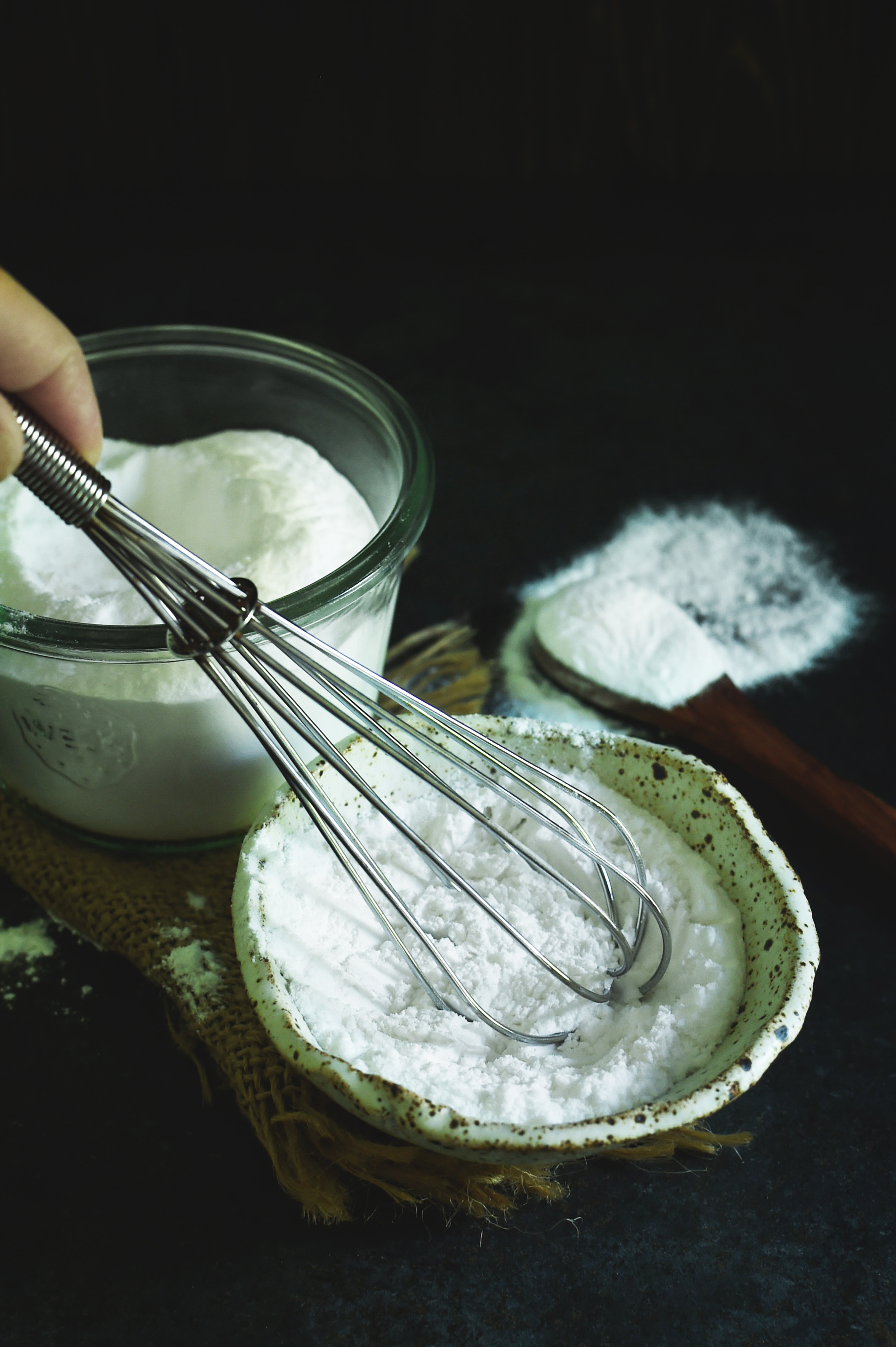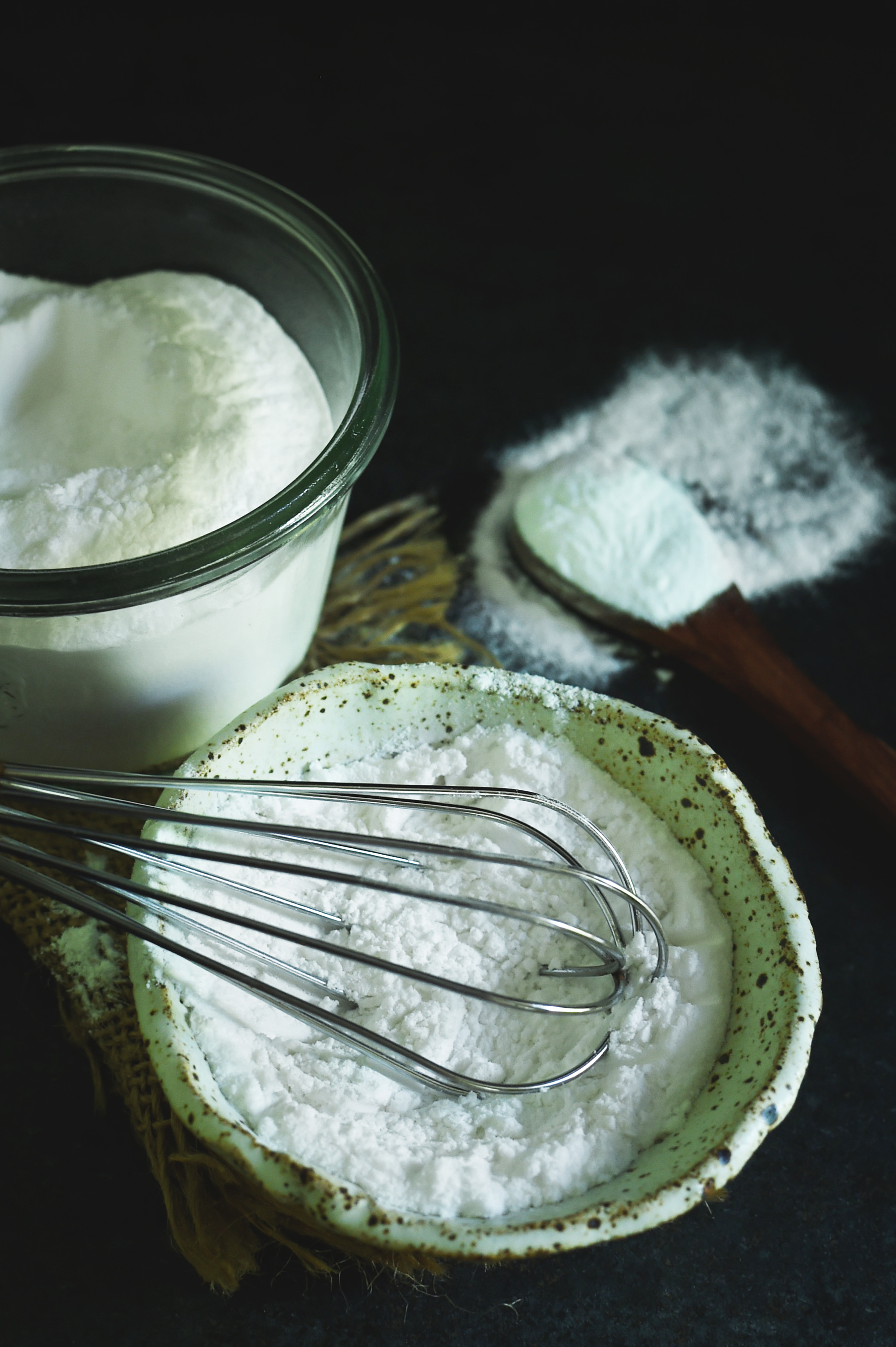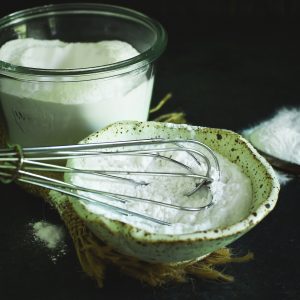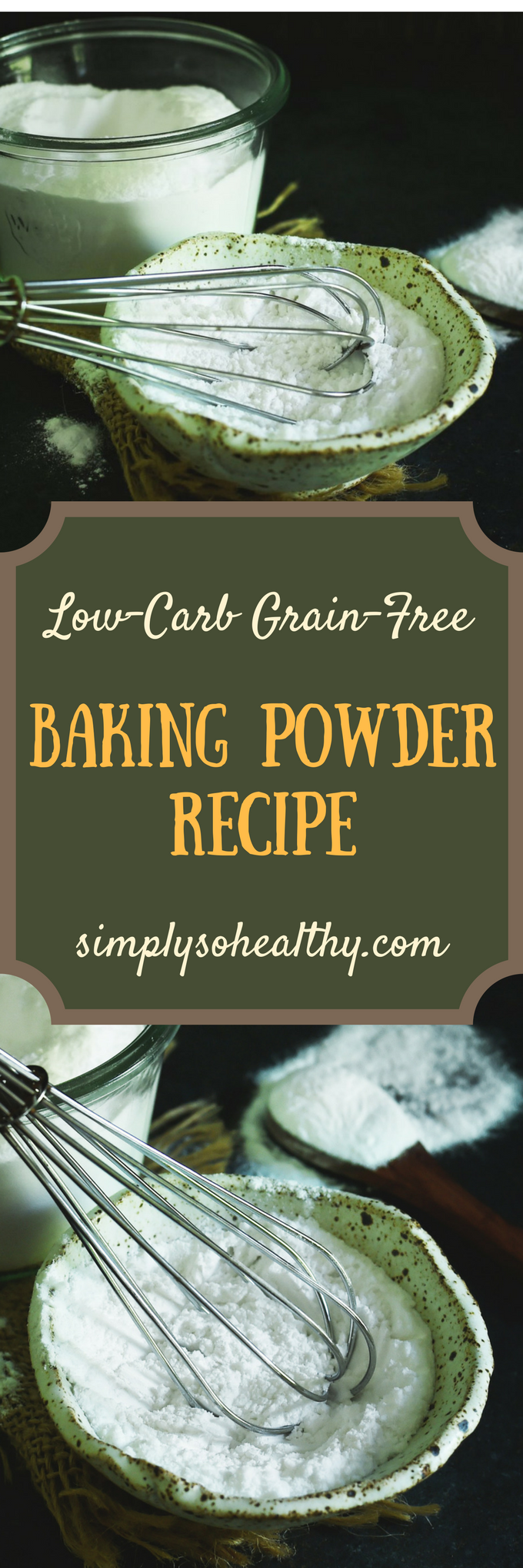This Low-Carb Baking Powder Recipe can be used in your favorite recipes. It’s free of starches, grains, and aluminum and will work for low-carb, keto, Atkins, diabetic, or Banting diets.

Disclaimer: Some of the links on this site are affiliate links which means we make a small commission from any sales to help keep the recipes coming! You do not pay any more. Thank you for your support!
How much do you know about the baking powder you use? Go get it and look at the ingredients. You will probably find ingredients that include aluminum and starches.
What is in Homemade Baking Powder, Anyway?
Usually homemade baking powder is made of three ingredients: baking soda, cream of tartar (a dry acid available at any grocery store), and a starch. Baking soda is a base and when combined with the acid, cream of tartar in a wet environment (like your favorite cookie dough), goes through and acid-base reaction giving off little bubbles of carbon dioxide. In short, it fizzes.
The carbon dioxide created with this fizzing action gets caught in the batter to create bubbles, causing the baked goods to rise. This rising action gives lightness to cakes, loft to cookies, and lift to biscuits.
So if the baking soda and the cream of tartar create the leavening effect, why do we need the starch? Well, the simple answer to that is that the starch is a filler. This doesn’t mean it doesn’t provide and important purpose, though. It bulks up the baking powder so it can be measured accurately.
Another function of the starch is that it helps soak up humidity. Water makes the baking soda and cream of tartar react together and the water in the air is no different than the water in your batter. As this reaction occurs in the container, there will be less reaction left to happen in your cookies and cakes. In short, humidity will weaken your baking powder.
What Do We Do About the Starch?
Some Solutions
I have seen some recipes online for low-carb baking powder that just leave out the starch, others that use extra cream of tartar instead. Both of these solutions are not without issues.
First of all, by simply leaving out the starch, we create a measuring nightmare. If a recipe asks for 1 teaspoon of baking powder, we would need only 2/3s of a teaspoon of a baking powder made without the starch. I just don’t want to do this much thinking while I’m cooking, not to mention, we have a limited number of measuring spoons available to us.
By using cream of tartar to make up the extra bulk, we take care of the measuring problem. However, we add extra acid to the recipe.
Another Alternative
To avoid these issues, I substitute a fiber for the starch. Using a fiber creates the bulk so the homemade low-carb baking powder measures teaspoon for teaspoon like commercial baking powder and doesn’t add excess acid.
The fiber I use is inulin. Unlike a starch, the body does not break inulin down into sugars. Instead, it passes through the small intestine undigested (1). When it gets into the large intestine, good bacteria feast on it helping them thrive (2). They break down the inulin into short chain fatty acids (SCFA) (3).
Short chain fatty acids go on to nourish and heal the cells of the large intestine. They even provide anti-inflammatory benefits(4).
Of course, with my baking powder recipe, there will be only a tiny amount in each serving, so these benefits will be negligible. I just wanted to note that the net effect of inulin on the body is positive, rather than negative.
While inulin has a pleasant, slightly sweet flavor, I find that the small amount in the baking powder does not affect the taste of the final baked good. It is even undetectable in savory baked goods, like my low-carb biscuit recipe.
I am getting excited about using inulin in more recipes. I like the taste of it, recipe potential and its health benefits. If you don’t have inulin on hand, other powdered fibers would probably work fine in this recipe. In a pinch, a grain-free starch, like arrowroot would work fine. Arrowroot would add some carbs (maybe too much for my keto followers), but a tiny bit per serving.

Final Comments
For best results with this Low-Carb Baking Powder Recipe, get the batter into the oven as soon as possible after mixing it up. This baking powder is a single acting baking powder and does not contain ingredients that will get a boost in leavening in the oven like a double acting powder will.
Use fresh ingredients in this baking powder as baking soda will lose its potency after a period of time. Also, don’t make a huge batch of this baking powder with the intention of keeping it for a long period of time as it will lose its potency as well.
This Low-Carb Baking Powder Recipe will help your favorite low-carb baked goods rise to perfection. Enjoy!
-Annissa

Low-Carb Baking Powder Recipe
This Low-Carb Baking Powder Recipe can be used in your favorite recipes. It's free of starches, grains, and aluminum and will work for low-carb, keto, Atkins, diabetic, or Banting diets.
Ingredients
- 1 tablespoon baking soda (fresh)
- 1 tablespoon cream of tartar
- 1 tablespoon inulin (a starch of choice may be substituted)
Instructions
Mix all ingredients together well. Use as you would any baking powder.
Keep in an airtight container at room temperature.
Recipe Notes
Serving size: 1/4 teaspoon
Per serving:
Calories: 2
Fat: 0
Carbs: 0(negligible)
Fiber: 0 (negligible)
Protein: 0





Thank you for the great ideas. Can I use corn starch instead of gram flour?
Corn starch would work fine, but would not be grain-free and would alter the nutritional values.
Could this be used as a low-carb thickener for gravy, stews, etc, like regular baking powder can?
I wouldn’t use it in this manner. Glucomannan is my favorite low carb thickener.
-Annissa
Thank you, Tara! Blessings on your week!
This is so informative! I had no idea what the ingredients in baking soda were or how they worked. It’s great to get a better understanding!
This is great information and a great alternative to the grocery store baking powder.
I had no idea you can make baking powder using baking soda. Must give it a go!
Honestly I had no idea, you could make the low carb baking powder.. Thanks for sharing this awesome recipe.
What a cool idea! I had no idea how to do this and I can’t wait to give it a try!
I love this idea! So if a recipe asks for 1 Tbsp of baking powder. How much of the corn starch/cream of tartar/insulin mixture should we add? 1 Tbsp as well?
Yes. I will say that the inulin is really just for a filler to make it measure correctly. If you want to use a teaspoon of baking soda and a teaspoon of cream of tartar, that would work just as well.
Also, I’ve found that the inulin gets a little sticky in a humid environment and makes this baking powder not last very long. If you want it to last longer, you may want to use a different filler, such as arrowroot starch.
Thanks so much! I’m doing Keto so will use the Inulin and just make it fresh each time! So if the recipe calls for 1 Tbsp of Baking Powder, I should use 1/3 Tbsp of Baking Soda, Cream of Tartar & Inulin, correct? I can’t wait to try this for waffles & muffins! Love your recipe idea! So informative:)
Absolutely! To make it easier, if the recipe calls for a tablespoon, a tablespoon contains 3 teaspoons, so it would be a teaspoon of each of the three ingredients. Enjoy those waffles!
-Annissa
Perfect, thanks so much!!
Thanks for your recipe. Since this baking powder is fast acting, do you recommend against freezing a cookie dough recipe that contains this baking powder? I love to prepare in batches and want to better understand if that could work.
Jen,
I would not use a single acting baking powder for a cookie dough that you plan to freeze. The “bubbling action” will be all used up before the cookies are baked.
-Annissa
Could arrowroot be used with the baking soda and cream of tarter? How long do you think it lasts mixed together? A week? A month? Thank you.
Absolutely. It will probably last a month or so if you use arrowroot, especially it isn’t particularly humid. The inulin can soak up humidity and get sticky.
Best,
Annissa
Thanks for the great tips. Would Psyllium husk powder (fiber) work in lieu of the inulin ?
I think it should work fine.
I’m wondering if I could use psyllium husk fiber or oat fiber. I don’t have inulin on hand.
I think that would work fine.
Where do you get Inulin?
Thank you for sharing all of your information.
I get mine from Amazon.
Oh MY, it looks great! Can’t wait to cook em this Sunday!